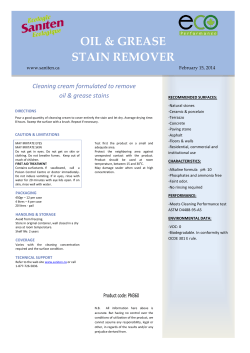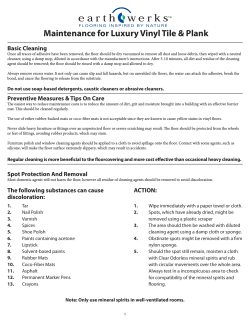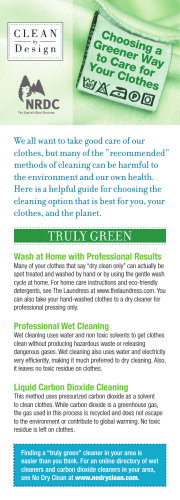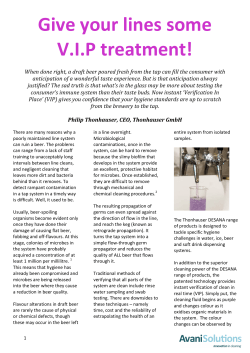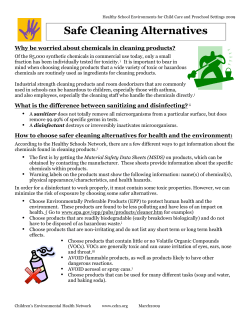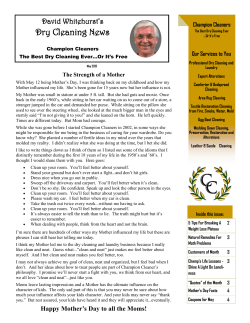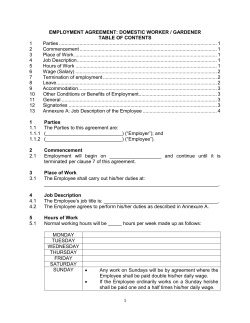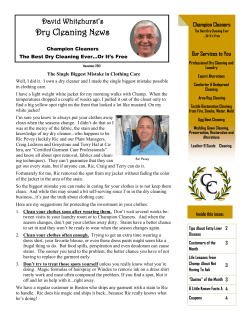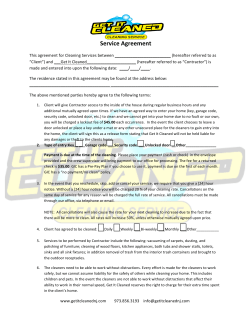
Document 168184
2011 marcfirst Janitorial Services Marketing Plan 1606 Hunt Dr, Bloomington IL, 61701 Project Goal: To establish a strategic marketing plan that helps marcfirst grow its cleaning services client base and generate a “contribution to overhead” of $25,000 within a year. 1 MopSquad Project Team: Munjal Dave, Carolyn Davis, Iwin Haung, Renee Lafontaine, Jon McWhirter, Sharonna Miller, Theresia Taylor marcfirst Janitorial Services 3/7/2011 Table of Contents Executive Summary 3 Project Background 4 Industry and Marketplace Assessment 6 Operational Research and Analysis 8 Marketing Strategies and Recommendations 12 1. Define a Target Market 13 2. Improve Marketing Activities 14 3. Enhance the Sales Process 16 4. Provide Exceptional Customer Service 18 5. Leverage Industry Best Practices 20 Appendix 21 References 24 2 I. Executive Summary With roots dating back to 1955, marcfirst is a well-known and respected local not for profit. The organization’s mission is to guarantee the personal dignity of people with developmental disabilities and to promote their personal achievements based on their dreams, desires and abilities. Following the closure of the Occupational Development Center in 2008, marcfirst took over several of the center’s commercial cleaning clients. During the past year, marcfirst has steadily increased the number of cleaning contracts, but remains unprofitable. A project team of seven individuals from the McLean County Multicultural Program was asked to develop a marketing plan for marcfirst Janitorial Services aimed at helping it achieve a $25,000 “contribution to overhead” within the next year. The team conducted industry and customer research, evaluated current operations and developed a marketing plan with recommendations over a six month period. Research Findings After experiencing a slump in 2008 and 2009, janitorial services industry revenues (currently at $42 billion) are expected to grow 3.2% annually through 2015. The janitorial services industry is fragmented with a number of small and medium-sized businesses competing for clients. Seven of the ten fastest growing franchises in the U.S. are commercial cleaning businesses. Profit margins for the janitorial industry tend to be fairly low (5.0%- 7.0% of revenues). To achieve the $25K “contribution to overhead” goal, marcfirst will likely need to see janitorial services revenues between $250K and $300K (depending on how fast revenues grow compared to expenses). Feedback received from existing clients was overwhelmingly positive with customers happy with the quality, expertise and price marcfirst brings to each cleaning job. marcfirst’s Janitorial Services growth challenges come from limited brand recognition, perceived lack of experience, inconsistent sales process, and possibly uncompetitive pricing. To support the organization’s growth and profit goals the project team recommends the following five areas of focus: 1. Define a Target Market – Identify and focus on a key segment of businesses and/or job sizes. 2. Improve Marketing Activities – Build strategies to leverage the marcfirst brand, make enhancements to the website, feature testimonials and encourage word of mouth marketing. 3. Enhance the Sales Process – Establish a consistent sales process with dedicated and/or highly trained sales representatives. 4. Provide Exceptional Customer Service – Continue providing exceptional customer service to clients. Look for ways to gather and respond to ongoing customer feedback. 5. Leverage Industry Best Practices – Consider joining an industry trade group (we recommend ISSA) and leverage the research and information available. 3 II. Project Background About marcfirst marcfirst’s mission is to guarantee the personal dignity of people with developmental disabilities and to promote their personal achievements based on their dreams, desires and abilities. The vision of marcfirst is to be a bridge to the community allowing people to pursue and achieve their dreams throughout their lives. The roots of marcfirst date back to 1955 when the McLean County Association for Mentally Retarded Children was established by families who had children with development disabilities. At the time, the organization’s purpose was to provide support for families and their children during a period when children with cognitive disabilities were often excluded from the public school system. The agency started serving the community with only five students. By 1972, the program had increased to 36 students, five classrooms, and five teachers with aides. In the fall of 1979, a federal law was passed stating school districts would be required to provide appropriate programs for children with developmental disabilities between ages 3 and 21. In 1980, the organization changed its name to Marc Center and then to marcfirst in 2007. Today, marcfirst provides a continuum of services and support for families, children and adults throughout their lifetime including residential, vocational development, employment, and therapeutic support. Services offered include: SPICE of marcfirst: A Pediatric Therapy Center provides early intervention services for the families with children from birth through early childhood, who have developmental disabilities or delays or are at risk for delay due to environmental or medical concerns. Supported Employment Program (SEP) helps people with developmental disabilities find and keep viable community jobs. Opportunity W.O.R.K.S. is an employment initiative aimed at businesses to develop career opportunities for individuals with developmental disabilities. Friends First is a newly founded drop-in program for adults who have developmental disabilities and are underemployed. Developmental Training (DT) is a program that supports individuals in developing skills to help facilitate independence in areas of adaptive living skills, therapeutic interventions, and professional development within the community. Community Integrated Living Arrangement (CILA) and/or Residential provides housing for adults at more than ten different sites throughout Bloomington-Normal community. 4 Project Description Following the closure of the Occupational Development Center (ODC) in 2008, marcfirst took over several of the commercial cleaning contracts the ODC had with local businesses. During the past year, marcfirst has steadily increased the number of cleaning contracts and hired additional employees along with an experienced manager to oversee the operations. Despite the growth in clientele, the cleaning services business is currently not profitable. Many of the services provided by marcfirst rely on reimbursement from the state of Illinois. Due to the ongoing state budget crisis, marcfirst has seen its operating revenues fall substantially, wherein the state of Illinois owes more than $1.0 million to marcfirst for services and support provided. To help offset some of this lost revenue, marcfirst would like to expand its cleaning services business and become profitable. The overall goal of the project was to establish a strategic marketing plan for marcfirst’s commercial cleaning services in order to help grow its client base and establish a “contribution to overhead” of at least $25,000 within the next year. Project Approach In September 2010, a project team of seven individuals from the McLean County Multicultural Program was formed and charged with developing a marketing plan for marcfirst Janitorial Services. Over a six month period, the project team evaluated the current commercial cleaning operations, conducted industry and customer research, and developed the marketing plan with recommendations as highlighted in the diagram below. This report is the result of their work. Understanding Current State Research and Analysis Envisioning the Future State • marcfirst organization • Goals/strategies of commercial cleaning business • Industry research • Current and potential customers • SWOT Analysis • Address challenges and opportunities • Synthesizing 5 Marketing Plan and Recommendations III. Industry and Marketplace Analysis Industry Overview While janitorial services account for about $42 billion of revenue a year, profit margins have been decreasing due to today’s continuing tough economy along with steep price discounts and rebates. The vast majority (85%) of industry revenues are derived from non-residential commercial clients, while residential cleaning represents less than 10% of industry revenues and the remainder generated from carpet cleaning and other services. Demand for cleaning services is driven by commercial real estate occupancy and consumer confidence. High vacancy rates in commercial buildings and cutbacks in the frequency of cleaning have also reduced growth opportunities. Over the past few years, the industry’s size has remained relatively flat. Janitorial Services Industry Revenues ($ billions) $60 $50 $40 $30 $20 $10 $0 2005 2006 2007 2008 2009 2010 2011 2012 2013 2014 2015 In a 2009 survey by Proctor and Gamble of over 1,100 small Source: IBISWorld businesses, more than one quarter (29%) said they have cut back on cleaning services. Some organizations discontinued their cleaning services, while others cleaned less often. The end result was a less clean workplace and longer cleaning times. After experiencing a slump in 2008 and 2009, IBISWorld predicts janitorial services industry revenues will grow 3.2% annually through 2015. Growth is expected in the hospitality and healthcare industries, long-term living facilities, federal government facilities and school districts. These industries historically have used in-house staff for cleaning, but are currently looking at outsourcing opportunities. Fastest-Growing Cleaning Services Franchises in 2011 # of U.S. Overall Franchises Rank* Franchise Name (2010) 1 Stratus Building Solutions 3,512 2 Jan-Pro 10,266 4 CleanNet USA 4,745 5 Anago Cleaning Systems 2,196 8 Vanguard Cleaning Systems 1,734 9 Bonus Building Care 2,750 10 System4 1,190 Source: Entrepreneur Magazine *rank among all types of franchises Anticipated industry revenue growth has also led to a number of franchising opportunities for start-ups. According to Entrepreneur Magazine, seven of the ten fastest-growing franchises in the U.S. are providers of commercial cleaning services. Profit margins for the commercial cleaning industry tend to be fairly low – ranging from 5.0% to 7.0% of revenue. The majority of costs related to this industry are employee wages and benefits (53% of revenues) and 6 cleaning materials and equipment (percent of revenues varies). As a result, operators are significantly affected by changes in labor costs or the cost of materials. Current research trends suggest in order to survive in today’s economy, smaller janitorial services such as marcfirst will need to create an efficient, cost-effective routine, be more responsive to customers’ needs and economic changes, while maintaining a high-level cleaning standard. Competitive Analysis The U.S. janitorial services industry consists of more than 50,000 providers. The industry is fragmented with few large companies and instead dominated by a number of small regional players and local “mom and pop” shops. The U.S. Census Bureau (based on 2008 data) estimates that 58% of janitorial services providers have less than four employees, 17% with five to nine employees and 12% with 10 to 19 employees. Only 82 cleaning services companies in the U.S. have more than 1,000 employees. Large janitorial service providers include ABM Industries and ServiceMaster, while local competitors include Nord Cleaning Service and Environmental Solutions & Services (ESS). Regardless of business size, successful firms are able to provide efficient services, use state of the art equipment, maintain employee retention and training, while serving multiple clients. Smaller companies that operate similar to marcfirst Janitorial Services are effectively competing in local markets by catering to small and medium-sized businesses. marcfirst is also facing competition from a number of “mom and pop” shops, which are often home-based businesses operating with little or no overhead. Selected Local Janitorial Services Competitors A Cleaner Finish Alpha Cleaning Services Allied Services Alpha Cleaning Corp. ANC Commercial Cleaning Environmental Solutions & Services (ESS) Great American Cleaning Services Kimco Corp. Nord Cleaning Service PRO Clean RFD Cleaning ServiceMaster Clean Vonachen Services Due to the number of players and ease of entry into this market, it is very difficult to assess the size and relative strength of local competitors. Additionally, the vast majority of companies are private and not subject to public disclosure of financial data. 7 IV. Operational Research and Analysis About marcfirst Janitorial Services Launched in 2009, the primary goal of the marcfirst Janitorial Services is to generate additional revenues, which can be used to help support marcfirst’s core mission. The commercial cleaning business is not aimed at necessarily providing employment opportunities to marcfirst clients with development disabilities. marcfirst’s Janitorial Services mission is to “exceed customer expectations for high quality, professional janitorial services.” Services provided include typical office building cleaning, including vacuuming, sweeping, dusting, restroom cleaning, along with specialized services like floor stripping and carpet cleaning. The organization uses safe, non-toxic cleaning chemicals with MSDS sheets available for all products. All janitorial employees are highly-trained professionals and have passed an extensive criminal background check, including fingerprinting and drug and alcohol screening. In addition, all staff is clean and professional in appearance and fully insured. The janitorial operations currently employs six individuals and one manager, Ron Woodrum, with over 30 years experience in the cleaning services industry. In addition to managing day-today operations, Ron also plays a key role in prospecting new business. marcfirst Janitorial Services currently has 14 clients, including a number of local not for profit agencies along with the City of Bloomington and Town of Normal. In addition, the operation is actively seeking new clients with a number of bids currently outstanding. To monitor prospects and the profitability of existing customers, marcfirst has implemented an A-B-C-E system. “A” companies are actively soliciting bids for cleaning services, “B” companies are under a vendor contract but would consider marcfirst at the next review cycle, and “C” companies do not contract out cleaning services, but instead rely on their own employees. Existing customer are identified as an “E” along with a 1 to 3 rating based on revenues and profitability (1 is the highest). Customer Research The project team evaluated overall customer satisfaction by visiting with a number of existing customers. Feedback received was overwhelmingly positive with customers happy with the quality, expertise and price marcfirst brings to each job. Although the satisfaction level with current customers is very high, current marketing and sales practices have not enabled marcfirst to gain additional business at a rate which would allow them to become profitable. 8 Contact was also made with a number of prospective clients to determine how they select a commercial cleaning contractor. The most frequent approach was to rely on word of mouth referrals or testimonials from other businesses. Many have been using the same cleaning service for a number of years and hadn’t considered using other vendors. However, a few mentioned that they have become dissatisfied with their current vendor and would be interested in considering marcfirst. Some organizations accept bids every few years to make sure the price they are paying remains competitive. In discussing the process with a local government official, it was determined the bid process for government facilities can be complicated. While the local official consider the process fair, a company like marcfirst is often found competing against other companies with stronger brand recognition and a more sophisticated sales process. Bidding/Pricing Process Research found that due to the nature of the commercial cleaning business, it is very difficult to assess the bidding process of competitors. Pricing information is considered proprietary with competitor bid proposals submitted directly to the client. Fortunately, the project team had an opportunity to review the bidding process and compare prices for one potential client. marcfirst and one other local company bid on the same job, with vastly different results, specifically in price variance. There was a significant price difference between the two companies with the marcfirst bid significantly higher. The competitor company was also considered by the potential client as providing a more professional bidding process, including requesting detailed information prior to the site visit, spending more time discussing the cleaning process and delivering a more in-depth bid document. In subsequent discussions with the potential client, marcfirst has since provided a much more competitive price which meets the client’s needs. Despite the lack of research available on pricing, this may be the biggest threat to marcfirst’s commercial cleaning operations. Pricing each job accurately is the key to winning new contracts, while still generating a profit. With average profits margins in the 5.0% - 7.0% range, there’s very little room for errors in pricing a cleaning job. Lastly, competing with small to medium-sized janitorial services companies may be a challenge. Depending on the target market, small companies may be able to operate with less overhead, allowing them to aggressively price their services. SWOT Analysis As the project team completed its research, a Strengths, Weaknesses, Opportunities, and Threats (SWOT) analysis was conducted. One major challenge identified is the lack of awareness in the business community of marcfirst’s commercial cleaning business. While the marcfirst brand is well-known and respected in the local community, it is not generally associated with janitorial services. To help in building the janitorial brand, the organization recently changed its operations from marcfirst Commercial Cleaning to marcfirst Janitorial Services. Other challenges include the perceived lack of experience in the commercial cleaning business, having no specific targeted client base and no association with an industry trade group. 9 marcfirst is currently bidding on a variety of job types and sizes, some of which would require a rapid increase in staffing and training. While obtaining a large commercial client may help marcfirst achieve their revenue goals, it may also lead to other challenges and resource issues as they try and maintain their existing client base. There are also a number of industry trade groups with resources available for helping to grow and sustain the commercial cleaning business. Membership in one or more of these groups provides access to research, conferences, and educational materials. In addition, most offer industry certification programs to help an organization differentiate itself from the competition. marcfirst Janitorial Services SWOT Analysis Strengths • Good knowledge of the cleaning business • Strong community-based organization • Excellent brand recognition and reputation • Personal connections with community leaders • Existing base of satisfied customers Weaknesses • • • • • • • • • • Brand isn’t associated with the cleaning business Very small client base Operations are currently not profitable Sales/bidding/marketing process is sub-optimal Lack of regular client communications Pricing may not be competitive No specific targeted customer base and/or job size Lack of certification/membership in industry trade organizations Website information is difficult for prospective clients to find Missing a systematic process to explore and identify customer needs as well as potential customers • Lead-generation process through website or other mechanisms is not systematic Opportunities • Cleaning services industry is growing • Trend is towards more outsourcing of cleaning needs by businesses • Many industry and trade resources are available • Marketing dollar investment is minimal since most growth comes via word-ofmouth Threats • • • • Prolonged economic downturn may result in more price-sensitive clients Ease of entry and fragmented marketplace results in many competitors “Mom & Pops” operating with minimal overhead may be difficult to compete against Well-established, more professional organizations with better management techniques and technologies may prove to be challenging competitors • Potential employee recruiting and retention challenges, especially as operations expand Revenues/Contributions to Overhead Projections The following scenarios are derived from marcfirst’s Janitorial Services 2010 actual results and 2011 budget. In order for marcfirst to achieve its goal of $25,000 “contribution to overhead,” the cleaning services business must grow revenues at a faster pace than expenses. This is especially challenging since the majority of expenses (~80%-85%) are tied to the labor costs needed to complete cleaning services jobs. Three scenarios are presented, based on the following assumptions: Scenario #1 – 80% revenue and 65% expense growth in 2012 and 2013; 10% revenue and 10% expense growth through 2015 10 Scenario #2 – 100% revenue and 80% expense growth in 2012 and 2013; 10% revenue and 10% expense growth through 2015 Scenario #3 – 150% revenue and 110% expense growth in 2012; 50% revenue and 40% expense growth in 2013; 10% revenue and 10% expense growth through 2015 Depending on the scenario, it appears that commercial cleaning revenues of $250,000-$300,000 are needed to generate a $25,000 “contribution to overhead” (assuming revenues can grow at a 20%-40% rate faster than expenses). marcfirst Janitorial Services Revenues/Contribution to Overhead Projections Scenario #1: 80% revenue and 65% expense growth in 2012 and 2013; 10% growth in revenues/expenses through 2015 Revenues Total Expenses Contribution to Overhead Margin before Overhead Revenue Growth Expense Growth 2010 2011 2012 2013 2014 2015 Actual Budget Forecast Forecast Forecast Forecast 70,172 119,338 214,808 386,655 425,321 467,853 83,612 125,400 206,910 341,402 375,542 413,096 (13,440) (6,062) 7,898 45,254 49,779 54,757 3.7% 80% 65% 11.7% 80% 65% 11.7% 10% 10% 11.7% 10% 10% Scenario #2: 100% revenue and 80% expense growth in 2012 and 2013; 10% growth in revenues/expenses through 2015 Revenues Total Expenses Contribution to Overhead Margin before Overhead Revenue Growth Expense Growth 2010 2011 2012 2013 2014 2015 Actual Budget Forecast Forecast Forecast Forecast 70,172 119,338 238,676 477,352 525,087 577,596 83,612 125,400 225,720 406,296 446,926 491,618 (13,440) (6,062) 12,956 71,056 78,162 85,978 5.4% 100% 80% 14.9% 100% 80% 14.9% 10% 10% 14.9% 10% 10% Scenario #3: 150% revenue and 110% expense growth in 2012; 50% revenue and 40% expense growth in 2013; 10% growth in revenues/expenses through 2015 Revenues Total Expenses Contribution to Overhead Margin before Overhead Revenue Growth Expense Growth 11 2010 2011 2012 2013 2014 2015 Actual Budget Forecast Forecast Forecast Forecast 70,172 119,338 298,345 447,518 492,269 541,496 83,612 125,400 263,340 368,676 405,544 446,098 (13,440) (6,062) 35,005 78,842 86,726 95,398 11.7% 150% 110% 17.6% 50% 40% 17.6% 10% 10% 17.6% 10% 10% V. Marketing Strategies and Recommendations “The purpose of business is to create and keep a customer.” – Peter F. Drucker, Father of Modern Management An effective sales and marketing approach of a business should align with the overall organizational strategy. This creates a coherent approach that delivers better results. Michael E. Porter, strategy guru from Harvard Business School, says there are three generic strategies organizations use to compete: 1. Low Cost – Organizations gain market share by appealing to cost-conscious or pricesensitive customers. Examples: Amazon.com, Walmart and Dell. 2. Differentiation – Companies provide a product or level of service that is perceived as different from other companies. Examples: Nike, Apple Computers, Mercedes-Benz. 3. Focus – Businesses focus on a narrow segment of the market and achieve success through cost leadership or differentiation. Ideally, a company should select a few target markets, usually distinct groups with specialized needs. Examples: Southwest Airlines and Family Dollar. It appears the most appropriate strategy for marcfirst to compete in the janitorial services business is the focus through differentiation strategy. By focusing on a select group of businesses, marcfirst can help build its brand and reputation among those organizations. marcfirst has a positive and solid image in the community to aid them in building the janitorial business. However, based on the project team’s research and analysis, there are several opportunities for operational improvement to achieve marcfirst’s growth goals. As a group, we recommend the following five areas of focus: 1. 2. 3. 4. 5. Define a Target Market Improve Marketing Activities Enhance the Sales Process Provide Exceptional Customer Service Leverage Industry Best Practices The recommendations are very broad in nature and have been described in detail in the following sections. 12 1. Define a Target Market Several business experts suggest that a successful marketing plan starts with defining a target market. A target market is a customer segment that a business has decided to target with marketing efforts and ultimately its products and services. marcfirst has a goal to grow the new found business at a rate that would produce a $25,000 “contribution to overhead” within a year. While pursuing this goal, marcfirst has yet to define a target market that would fit their business model. Currently, the organization is considering all potential prospects as clients – no matter how big or small the job size. By not specifically focusing on a certain segment of the market, marcfirst risks losing out on potential revenues and/or profits as it tries to compete against more specialized providers. Major Market Segmentation (2010) Small Retail; Restaurants, 6.0% Educational Facilities, 5.0% Offices, 53.0% Large Retail & Grocery, 8.0% Industrial Plants, 8.0% Healthcare Facilities, 8.0% marcfirst’s Janitorial Services business model is targeting commercial properties. According Residences, to IBISWorld, 88% of the national janitorial 12.0% Source: IBISWorld services market is non-residential. Further refinement of this broad category will help marcfirst determine where their prospecting efforts should be placed and provide focus for the sales process from beginning to end. 13 2. Improve Marketing Activities Several marketing channels can be utilized to help build a company’s brand and it is important to select the “right” marketing channel. Some products and services sell better using one channel, while others are more effective with different marketing strategies and tactics. marcfirst’s goal is to increase awareness about the janitorial services offered, attract new customers and increase services used by existing customers. Based on the goal and services offered, recommendations are listed below to aid in the growth of the company. a. Leverage the marcfirst Brand Many companies work very hard to build their brand and company profile. marcfirst has been building a positive brand since 1955. This brand can be used as a means of promoting marcfirst Janitorial Services. b. Conceptualize and Build Positive Word of Mouth Activities One of the most effective marketing tactics to build or damage a brand is word of mouth. marcfirst has the opportunity to build off its well-known and respected brand and provide a service that people will want to talk about. Because of the personal element added by word of mouth marketing, there is a layer of credibility added each time the story is communicated. That is why word of mouth marketing is so powerful. Positive word of mouth has to start with marcfirst. There are several ways marcfirst can build a word of mouth strategy: Storytelling Joining social groups (personal and business) Showcasing before and after pictures of cleaning jobs c. Utilize the Internet Internet marketing is an inexpensive communication tool, especially when comparing the ratio of cost to the reach of the target audience. Companies are able to access a wide audience for a small fraction of a traditional advertising budget. By utilizing the internet, marcfirst can conceivably achieve the following: Establish a stand-alone janitorial services website to house current service offerings, contact information, customer testimonials, before and after pictures, request for quotes, and frequently asked questions. Utilize social media such as Facebook and Twitter. Social media is an easy avenue to use, however to ensure effectiveness, the sites should be active and engaging. Solicit candid feedback from customers by offering online surveys. Although companies hope to only receive positive feedback, any negative feedback can be used to aid in the growth of clientele and services. 14 d. Build Compelling Marketing Material Services can sometimes be hard to sell because they are not tangible. Customers cannot see, smell or touch the service being offered. However, marketing material can be created to showcase the promise of excellent customer service and the ability to complete the job professionally. Documents such as service offering flyers, before and after pictures, and brochures can be used as visual aids of the quality and expertise marcfirst brings to every job. They can also be used to prospect new customers and inform existing customers. e. Integrate Lead Generation and Awareness Activities Sales promotions and discounts are beneficial when running a successful commercial cleaning business. In today’s world, consumers love finding deals. marcfirst should take full advantage of their existing resources to build additional prospects. Lead generation activities could include promotions, specials, coupons, gift certificates, and referral programs. The activities listed above will serve a dual purpose. It is a driver for new business and also a way to promote services to existing clients. f. Build a Tagline to Represent marcfirst Janitorial Services A tagline can communicate, to existing and potential customers, what sets marcfirst apart from other janitorial services. The tagline should be unique, simple and have an emphasis on benefits for customers. Below are a few examples of possible taglines marcfirst could use: 15 The Ultimate Cleaning Experience Cleaning with a Purpose A Better Clean Bridging Your Cleaning Gap 3. Enhance the Sales Process The primary purpose of a sales process is to proactively engage with potential clients and successfully move them from prospect to customer and then ultimately to becoming an advocate. A prospect is someone who has engaged with a business in some way. A lead has a recognized need that could be fulfilled by the organization. A customer is someone who is currently contracting with the company. An advocate is a very satisfied customer that proactively gives out referrals. This last category is the ultimate goal for marcfirst, since word of mouth marketing is a very effective way to grow commercial cleaning clients. The major reason for having a systematic, well thought out sales process is to standardize customer interaction. Creating a consistent customer experience reinforces the level of service a customer can come to expect. Businesses sometimes have a tendency to focus efforts on daily business operations and serving existing client demands. However, it is critical to the success of the business to focus on obtaining new business from current and potential customers in order to grow and sustain the company. Prospect Lead Customer Advocate After analyzing marcfirst operations, it was determined there are inconsistencies in the selling and bidding process for all potential and/or existing clients. In order to grow the book of business and become profitable, marcfirst will need to focus some attention on building a comprehensive sales process utilizing the components described below. a. Establish a Formal Written Sales and Bidding Process Research has found that less than 40% of companies have a formal sales process. Companies that deploy a formal sales process, when compared to the mean, win 48% more accounts, have sales cycles 37% shorter and generate two times more revenue per salesperson. An easily repeatable sales process is key success factor for any business. According to sales consulting company, Market-Partners, the sales process is the “road map that coordinates and aligns all activities and resources to the critical goal of acquiring and keeping a customer.” marcfirst should focus their efforts on developing a focused and dominant sales process for the team to utilize. A formal written sales and bidding process allows for: Integration of existing practices and methodologies Shorter sales cycle Skills and performance needs analysis Increased sales productivity Aligned and coordinated resources Increased revenue Decreased costs 16 Market-Partners contends that the sustainability of organizations engaged in business-tobusiness selling will “depend on their ability to build and maintain a high performance sales organization through the design, implementation and management of the optimal sales process.” b. Hire or Train a Dedicated Sales Professional A trained sales professional is critical to the success of sustaining and obtaining new business. marcfirst currently has a subject matter expert (SME) acting as the sales consultant. There are benefits in having SME as a part of the sales/bidding process. However, it is also important that individuals involved in the sales process receive professional sales training. The sales professional is the face of the company. The person should be equipped to handle all sales objections that may be uncovered in the sales process. c. Utilize Templates for both Sales and Bidding Well-defined professional sales and bid documents should be used when prospecting new and existing businesses. There is much benefit to creating templates for key work activities including: Capturing interaction with prospects and customers Bid/proposal management Pricing/costing analysis Follow up and closure (See Appendix A for a list of common practices to consider including in a sales process template.) d. Explore Third Party Tools for Process Automation These are generally referred to as sales force automation or customer relationship management tools (e.g., salesforce.com). Many of these tools are offered at a significant discount to the not for profit segment. 17 4. Provide Exceptional Customer Service Organizations like marcfirst Janitorial Services already understand the importance of attracting and retaining loyal customers. The cleaning services operation has established a small base of very satisfied clients. As the organization continues to grow, marcfirst must remain committed to providing exceptional customer service. Many companies today are focused on providing high-quality customer service while communicating the value of satisfied customers to the organization. However, businesses can believe they are providing “high quality customer service,” but without the validation from customers, the organization will never truly know the perception of the company. The worst publicity for any company is negative word of mouth. According to Kyle LaMalfa, Allegiance Best Practices Manager and Loyalty Consultant, companies are losing customers at a staggering rate, without really hearing from any of them. Each year, an average company loses 10-15% of its customer base. (Bain & Company) 84% of customers who leave, do so because of poor customer service. (Forum Corp) A typical business only hears from 4% of dissatisfied customers – the other 96% leave, 91% for good. (Jim Barnes, “Secrets of CRM”) Listed below are customer retention strategies to ensure the highest level of customer service to all businesses that choose to partner with marcfirst Janitorial Services. Although these strategies may seem obvious, they are not always practiced consistently and can sometimes be forgotten. Superb customer service is a simple yet powerful differentiation strategy. a. Satisfy the Customer with the Services Provided Customers solicit businesses due to a product or service need. Therefore, the service itself needs to meet the customers’ expectations. If the primary need cannot be fulfilled with service as a standalone, customers will choose to leave before engaging in the next level of customer satisfaction. Perfection of the service is invaluable to the company and is the first step in creating a pleasant customer experience. Developing the relationship with engaging conversations will enhance the customer experience. b. Intentionally, Purposefully and Proactively Create Dialogue with Customers Meaningful customer interactions can showcase positive and negative areas of the operation. Engagement with the customer opens up a channel of communication for necessary feedback. When customers are engaged with their service providers, they become an active participant and promoter of services offered. Feedback can be sought through unbiased surveys, online complaint forms, check points, and everyday work conversations. 18 c. Proactive and Consistent Resolution of Customer Feedback Based on the statistics provided above, customers will quickly switch service providers if they feel customer service is lacking. In the previous bullet, suggestions were given to solicit and attain feedback. However, the information is useless if it is not utilized. Customers expect the provider of choice to be acutely responsive to customer questions, comments and complaints. Research indicates when a customer’s concern is quickly resolved they can become a highly loyal and satisfied customer. Additionally, this unstructured feedback can be a great source of ideas. 19 5. Leverage Industry Best Practices There are a number of industry trade groups with resources available to assist with growing a cleaning services business. Membership in any of the groups highlighted below provides access to research, conferences, and educational materials. Based on the project teams assessment, ISSA appears to be the most beneficial trade group for marcfirst to join. ISSA – The Worldwide Cleaning Industry Association ISSA represents more than 5,500 worldwide distributors, manufacturers, building service contractors and associated service members. In addition to hosting large cleaning shows, ISSA provides educational products, industry standards, periodicals, and legislative and regulatory services to the cleaning industry. The association is headquartered in Lincolnwood, IL with regional offices in the Netherlands, U.K., Mexico, and China. ISSA also offers a certification program called Cleaning Industry Management Standard (CIMS). The certification is a way to differentiate a cleaning services company from other competitors and to demonstrate commitment to quality and customer satisfaction, while maintaining an optimum level of operational excellence. Currently, Vonachen Services out of Peoria is the only CIMS certified company in Central Illinois. (See Appendix B for more on ISSA membership.) IFMA – International Facilities Management Association IFMA is the world’s largest international association for professional facility managers, supporting more than 19,000 members in 78 countries. Association members manage more than 37 billion square feet of property and annually purchase more than $100 billion in products and services. Formed in 1980, IFMA certifies facility managers, conducts research, provides educational programs, recognizes facility management certificate programs and produces an annual facility management conference and exposition. IICRC – The Institute of Inspection, Cleaning and Restoration Certification The IICRC is a non-profit certification body founded in 1972 to establish and monitor educational programs for the inspection, cleaning and restoration services industries. The IICRC is owned and controlled by 14 industry trade associations and 3 individual shareholders. The group provides certifications in 24 different categories (related to inspection, cleaning, and restoration). BSCAI – Building Service Contractors Association International Established in 1965, BSCAI is a trade association for the building service industry, representing a worldwide network of 1,800 member companies. Member companies provide cleaning, facility maintenance, security and other related services to building owners and managers. The association provides educational programs, certification, publications, video training programs, seminars, and networking opportunities to the building service contracting industry. 20 Appendix 21 Appendix A – Common Practices for Sales/Bidding Process Initial Contact The most common initial contact marcfirst will incur is a “cold call.” Listed below are some ideas to aid in the process of turning a cold call into a warm prospect. o Determine objectives/purpose of the call. o Be prepared with information needed during the call. o Let them know the purpose of the call quickly. o Ask questions. Try and understand the potential client’s needs. o Make statements that build rapport and confidence. o Be professional, sincere, and friendly. Use appropriate humor. o Provide the prospective client with information prior to the cold call. This creates an opportunity to reference something during the call. Sales Presentation o Ensure adequate preparation is completed before the sales presentation such as requesting and evaluating the organization’s floor plans. o Be excited and show enthusiasm about the services marcfirst has to offer. o During presentations, focus on the benefits and what makes marcfirst different from the rest of the competition. o Set objectives for sales calls. Be prepared, relaxed, and professional. Always follow through on promises. o Let the prospects talk 90% of the time and listen – they will tell you how to sell to them. o Use customer testimonials. o Adapt the sales presentation to the prospect. Highlight areas that the prospect seemed most interested in. o Guarantee the services you provide. 22 Appendix B – ISSA Membership Details ISSA Membership Details ISSA membership for marcfirst would cost approximately $450 annually (price dependent on business size) and provide the following benefits: o Listing in ISSA’s Buyer’s Guide directory o Access to the electronic monthly newsletter o Notification of bi-weekly new tip videos o Subscription to ISSA Today magazine o One free tradeshow badge (scheduled for October 18-21, 2011 in Las Vegas) o Access to ISSA’s legislative and regulatory team ISSA has also developed work loading software (called Info Clean 2.0) and estimating tools to assist with job bids. It also publishes a book on average cleaning times for a variety of jobs. ISSA offers a bundle of their top business tools (including the three mentioned above) to ISSA member companies for $215. ISSA Contact Information 7373 N. Lincoln Ave. Lincolnwood, IL 60712-1799 Tel.: 800-225-4772 Email: [email protected] Web: www.issa.com 23 References Annual Industry Survey by Lisa Kopochinski, Services Editor, Services Magazine (Jun/July 2010) Discover the Guru in You: The 7 Insider Secrets to Finding, Landing, and Keeping Profitable Cleaning Jobs by Dan Liebrecht and Tony Dietsch, Celebrity Press (March 1, 2010) How to Start a Cleaning Service – www.entrepreneur.com/article/41426 Industry Trends & Projections by Lisa Kopochinski, Services Editor, Service Magazine (Aug/Sep 2010) The Initial Sales Contact by Small Business Notes – http://www.smallbusinessnotes.com/marketing-your-business/the-initial-sales-contact.html Janitorial Services in the US, IBISWorld (October 2010) Keep Proactive to Keep Your Customers by Lisa Kopochinski, Services Editor, Services Magazine (Feb/Mar 2010) Marketing Your Business in Tough Times by Lisa Kopochinski, Services Editor, Services Magazine (Feb/Mar 2010) The Sales Presentation by Small Business Notes – http://www.smallbusinessnotes.com/marketing-your-business/the-sales-presentation.html Sales Process – The Key to Customer Acquisition by Market Partners Inc. – http://www.market-partners.com/Documents/SProcess.0301.pdf The Top 9 Ways to Increase Your Customer Loyalty by Allegiance http://www.allegiance.com/documents/Allegiance_Top_9_Ways_to_Increase_Customer_Lo yalty.pdf Transitioning Beyond Green: A Look At The Future Of The Cleaning Industry by Stan Mierzejewski and David Holly, CM/Cleaning & Maintenance Management Magazine, Volume 46, Issue 9 – September 2009 Year in Review & Industry Forecast – Tough Times Still Lay Ahead But Optimism Prevails by Lisa Kopochinski, Services Editor and Chloe Raimey, Services Magazine (Feb/Mar 2010) 24
© Copyright 2025
